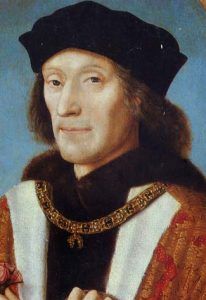 |
The king was the central figure of government in the reign of Henry VII. The inner circle of nobility that advised Henry VII was known as the Royal Council. The largest group within the Royal Council was those with a church background. Between 1485 and 1509, just about 50% of Henry’s council was made up of clerics. Two of the most favoured members of the Royal Council were John Moreton who was Chancellor from 1487 on and was later appointed Archbishop of Canterbury and Richard Fox who served as the King’s Secretary and was Bishop of Winchester.
There were also nobles on the Council, which seems to go against the belief that Henry wanted to push aside the nobility from government. However, anyone in the Royal Council was in it for two reasons – their ability and their loyalty to the king. Henry expected members of the Council to work for him in an effective and purposeful manner. Those nobles who served Henry well were suitable rewarded. The Earl of Oxford (John de Vere) was Great Chamberlain and Lord Admiral. Jasper Tudor, Duke of Bedford, became the most powerful nobleman in Wales. Henry was also willing to bring in members of the York family as long as they could be trusted. Thomas Howard, Earl of Surrey, was made Lord Treasurer in 1501.
Even within the Royal Council there was an elite inner circle that had far more access to Henry VII than others. These included his uncle Jasper Tudor, Duke of Bedford, the Earl of Oxford and Lord Stanley, his step-father.
Henry also relied on educated professionals, especially lawyers, as advisors. Because he was exploiting Crown lands to a much greater extent, Henry needed men trained in auditing, property law and administrative skills. Because men skilled in these areas were so valuable to Henry, he had little care from what social class they came from – only their ability mattered to him.
As much as was physically possible, Henry attended meetings of the Royal Council so he was very aware of what was being discussed.
From 1485 to 1509 there were a total of 227 royal councillors. But at any one time there were no more than 150 and only some of these attended a meeting of the Royal Council where attendance usually totalled about 40 members. They advised the king on matters of state and acted in a judicial capacity.
Henry continued a previous practice of using committees made up of members of the Royal Council. Each had its own area of expertise such as the Court of Requests (this dealt with legal cases involving those who could not afford the high costs of the normal system), the Court of General Surveyors (Crown lands) and the Council Learned in the Law.
The Council Learned in the Law – usually referred to simply as the Council Learned – was a small and highly professional legal committee. It was introduced in 1495 to defend Henry’s position as a feudal landlord. It initially dealt with the Duchy of Lancaster and the Chancellor of the Duchy was put in charge of the Council Learned. However, its went on to deal with all Crown lands and kept up-to-date records of wardship, marriage and relief of all the king’s tenants and the collection of feudal dues that were owed to him. The Council Learned acted without a jury and as it actively advanced the position of the king, it had his full support. In 1504, Sir Richard Empson became Chancellor of the Duchy and President of the Council Learned. He rigorously asserted royal feudal rights and later admitted that he made up feudal dues in more than 80 cases.
“By the end of the reign it had become the most detested but the most important of all Henry’s institutions of government involved in the maintenance of law and order.” (Caroline Rogers)
